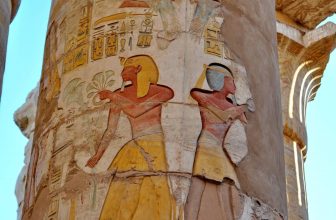The Colossi of Memnon are two huge stone sculptures of Amenhotep III, the Egyptian king who ruled during the Eighteenth Dynasty. They have stood in the Theban Necropolis, west of the Nile River from the present city of Luxor, since 1350 B.C.

The Colossi of Memnon are the most well-known monuments on the West Bank. These massive sculptures stand right before the main West Bank ticket office, alongside the major road that goes from the Luxor neighborhood of Al-Gezira on the west bank of the Nile.
They depict Amenophis III seated on a cube-shaped throne, and originally stood watch at the entrance to the king’s temple, of which only meager remnants remain.
They were taken for sculptures of Memnon, son of Eos and Tithonus, who was killed by Achilles during the Trojan War during Roman Imperial times.
The Colossus of the South is in better condition than the one to the north. It rises 19.59 meters tall, with the base partially covered in sand. The entire height must have been around 21 meters with the crown that it once wore but has now disappeared.

The North Colossus is the well-known “musical statue” that drew crowds throughout the Roman Imperial era. The story that Memnon was welcoming his mother, Eos, with this gentle, mournful sound arose from visitors’ observations that the statue produced a melodic note at daybreak. After Emperor Septimus Severus had the upper half of the statue repaired, the sound stopped.

You can see the huge site (now being excavated by archaeologists) where Amenophis III’s temple once stood if you go behind the statues.














